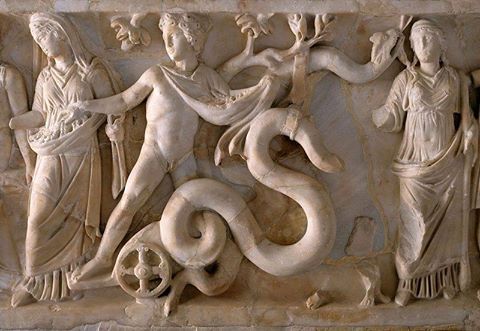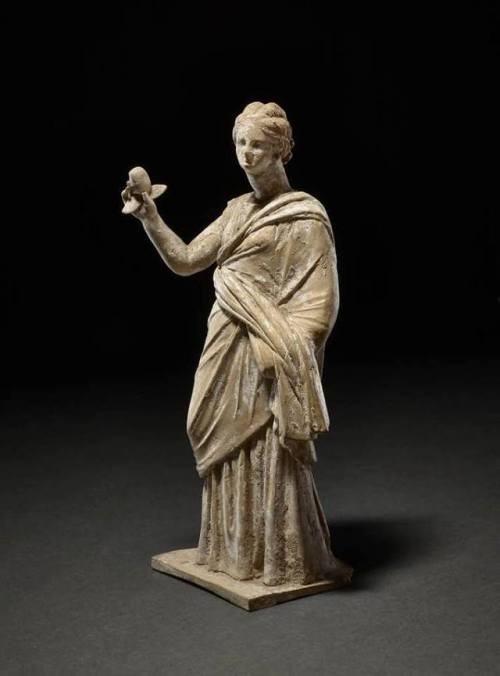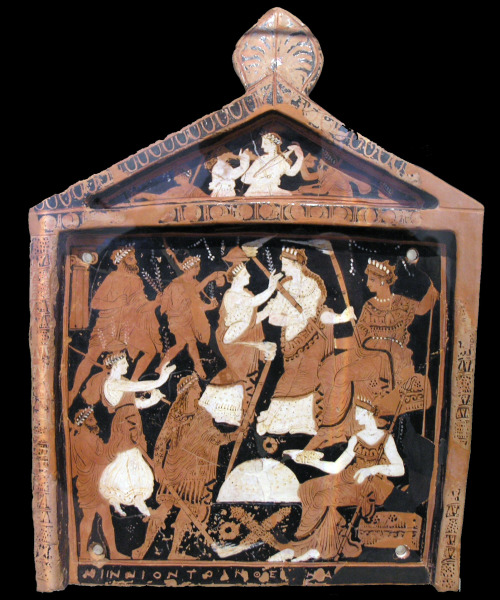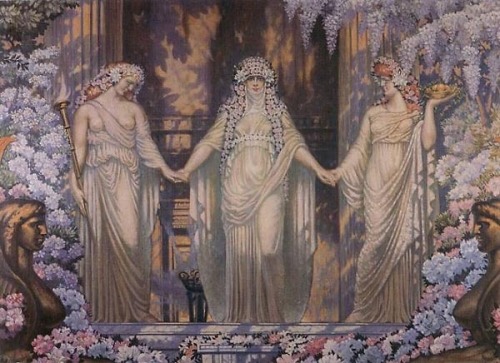#eleusis
Τετάρτη Μεσοῦντος/ Τετρὰς ἐπὶ δέκα/ Τεσσαρεκαιδεκάτη, XIV day
From today’s sunset: fourteenth day of Boedromion.
The epheboi escort back the Sacred objects from Eleusis to the Eleusinion in Athens.
“…it must be ordained to the cosmete of the epheboi to lead the youths at Eleusis in observance of the ancient customary rule on the 13th of the month Boedromion, in the usual form of the procession that accompanies the sacred objects, so that on the 14th they accompany back the sacred objects up to the Eleusinion in the City, so that there are more discipline and greater surveillance over the sacred objects, when the phaiduntés of the Two Goddesses, according to the traditions of the Homeland, announces to the priestess of Athena the arrival of the sacred objects and of the escort …” (IG II2 1078)
(Caryatid from the roof of the small Propylaea in Eleusis, bringing on her head the ciste, holding the Sacred objects. Eleusis Museum)
Post link
Ἑβδόμη Μεσοῦντος/ Ἑβδóμη ἐπὶ δέκα / Ἑπτακαιδεκάτη, XVII day
From today’s sunset: seventeenth day of Elaphebolion.
“Throw out Demeter’s holy grain upon the well-rolled threshing floor on the seventh of the mid-month. Let the woodman cut beams for house building and plenty of ships’ timbers, such as are suitable for ships.”
The scholia add: “If, as Orpheus says, the seventeenth day is dedicated to Ate, and therefore it is suitable for cutting the wood and for stripping the fruit from its coverings, also Hesiod, not without love for the Muses, consecrated the day to these works.”
Erga, 805-808
(Detail of a sarcophagus - Triptolemus with Demeter and a Goddess. Mid 2nd century CE. Now in the Louvre..)
Post link
Εἰκοστή/ Εἰκὰς/ Εἰκοσάδες, XX day
From today’s sunset: twentieth day of Anthesterion.
ΜΙΚΡΑ ΜΥΣΤΗΡΙΑ - I day of the LESSER ELEUSINIAN MYSTERIES
Sacred Εἰκὰς: the twentieth of each month is always sacred to Apollo and Athena.
“Every year two mystery cults are celebrated in honor of Demeter and Kore, the Lesser and the Great (Mysteries). The Lesser take the form of a purification and attainment of a state of purity, preliminary to the Great Mysteries.” Schol. Pluto 845f
“The Great Mysteries were in honor of Demeter, the Lesser in honor of Her Daughter Persephone.” Schol. Pluto 846
***
Moreover, “On the great twentieth, in full day, a wise man should be born. Such a one is very sound-witted.”
“He (Hesiod) calls it ‘great’ because it contains most of the days of the month; therefore all the day is suitable for birth, or he (Hesiod) has called it 'great’, as if it were completing great undertakings. The one who is generated in this day is very virtuous and learned.”
Hesiod and scholia, Erga, 792
(Terracotta figure of Persephone standing,Her right hand raised and holding a pomegranate. From Tanagra, 270 BCE. Now in the British Museum…)
Post link
honestly the greek gods are so funny and not even for the reasons and not even for the reasons you might normally think. like yeah i do get a good chuckle out of things like dionysus’s antics but one of the funniest stories to me in greek mythology is the one where demeter wants to thank a king for his hospitality towards her and the best way she can think to do that is to chuck his kid into a fire
Eleusinian Mysteries: Persephone, Triptolemos, and Demeter, on a marble bas-relief from Eleusis, 440–430 BC
Post link
Votive plaque depicting elements of the Eleusinian Mysteries, discovered in the sanctuary at Eleusis (mid-4th century BC)
Post link
Amphora from cemetery at Eleusis, Attica, attributed to the Polyphemos Painter, second quarter of seventh century BCE (Neer 4.24)
Post link

The Cult of Eleusis had a bi-annual rituals; in the spring “the lesser mysteries” in the fall. “the greater mysteries”, for over 2000 years, where all citizens (royalty and slaves alike) would make a pilgrimage to Eleusis to partake in a festival and initiation ritual tied to the myth of Demeter and her daughter’s kidnap by Hades into the underworld. This festival and ceremony would essentially initiate you, provide some spiritual insight, thereby guaranteeing a better position in the afterlife. (similar to a baptism guaranteeing a position in heaven, perhaps.) Only those who had committed murder or who could not speak greek were refused to participate.
Citizens would make the 15 mile walk from Athens, all the while being shouted profanities upon by onlookers, to break down their egos. Unfortunately, as the crime of revealing the inner ceremony of the mysteries would be punishable by death, we can’t know for sure what took place in the inner sanctum during the main ceremony. What we do know is that something was drunk and something was “seen”. Many believe that the drink offered to initiates, the KYKEON, would produce a psychotropic, hallucinatory effect. (perhaps tainted with ergot (rotten barley fungis), or maybe mushrooms.) Apparently the ritual had 3 stages (mirroring Persphones underworld journey) the descent, the search, and the ascent. Some believe the final act shown to the initiate was the cutting of an ear of grain, to symbolize the cyclical death and rebirth of nature.
I drew Demeter holding her torch she uses to search for her missing daughter, and an ear of wheat grain to symbolize her role in agriculture. to the left we have the main players of the lost daughter myth. Hades behind, and Persephone in front, with Hecate beside, who helped Demeter find her daughter, and became Persephone’s attendant in Tartarus. On the right we have a woman pouring libations to help the wheat grow, then Demeter holding the cut grain.
girl help I got emotionally attached to the drawing of a pig I made to sacrifice for the Eleusinian Mysteries

his name is oinkers
Have a pleasant, safe, meaningful and fun celebration to those celebrating the Eleusinian Mysteries, Equinox, and/or full moon!
sorry i’ve been gone im. exhausted ily all
Proclus, the neoplatonic philosopher, although subsequent and therefore not present in the Eleusinian Mysteries, mentions that the officiator of the mysteries used the invocation cry “Ύε κύε!” to gather the protection and power of both the heavens and earth, or else of both the male and female aspects of divinity.“Ύε” may possibly be translated as “You may rain” and “κύε” as “You may incubate”, a ritual reminding us the sexual intercourse and also the fourth stage of the seven operations of alchemy, Conjunction. Mentally this state of being is close to what is called the true self, the union of the male and female sides of our personalities into a more intuitive yet authentic state of consciousness.
Post link







